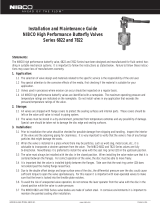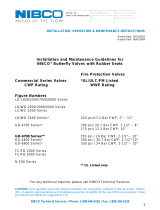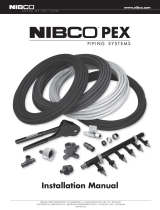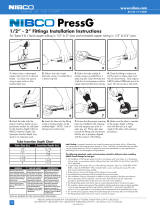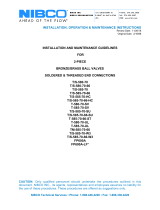
AHEAD OF THE FLOW
®
www.nibco.com
NIBCO INC. WORLD HEADQUARTERS • 1516 MIDDLEBURY ST. • ELKHART, IN 46516-4740 • USA • PH: 1.800.234.0227
TECH SERVICES PH: 1.888.446.4226 • FAX: 1.888.234.0557 • INTERNATIONAL OFFICE PH: +1.574.295.3327 • FAX: +1.574.295.3455
www.nibco.com
4
Revised 06/03/2009
III. GEAR OPERATOR INSTALLATION HANDWHEEL POSITIONING
TABLE 2
INSTALLATION
1. Install handwheel (1) onto gear operator shaft and secure with pin (2). (If not
already attached) See Fig. 1.
2. Turn the handwheel (1) clockwise until in full SHUT position.
3. Remove 2 screws holding pointer cover plate to center of gear operator to expose
bore. Retain pointer cover plate and screws for reinstallation later.
4. Assure valve is in full SHUT position, turn valve stem (5) to close disc if
necessary.
5. Assure both mounting base of gear operator (3) and valve top flange (6) are clean
and dry.
6. Determine desired handwheel position in reference to the piping system and
compare with Fig. 2. There are 2 mounting positions for the gear operator onto
the valve and the valve can be mounted in either direction into the piping system.
This will allow handwheel to be positioned in any of the 4 quadrants as shown in
Fig. 2. Note that all Fire Protection and 10" and 12" size commercial valves only
allow for handwheel positioning in quadrants 1 and 2.
7a) Gear operators with adapter bushing.
• Insert adapter bushing (4) into gear operator (3) bore aligning bushing key with
desired keyway. Keyway selection will determine handwheel orientation posi-
tion. (Note that Fire Protection model adapter bushings differ from illustration
and only have 1 keyway position).
• Align adapter bushing (4) bore with valve stem (5) and slide gear operator
assembly onto valve stem (5) until seated with valve top flange.
7b) Gear operators without adapter bushing.
• Align gear operator (3) bore with valve stem (5) and align with desired keyway.
Keyway selection will determine handwheel orientation position.
• Slide gear operator assembly onto valve stem (5) until seated with valve top
flange.
8. Secure gear operator (3) to valve top flange (6) using supplied* fasteners (7 & 8).
9. Reinstall pointer cover plate onto gear operator removed in step 3 above. Arrow should be aligned to indicate SHUT positon.
10. Install flag and secure with Allen Screw. (Fire Protection gear operators only.)
11. Rotate handwheel from full SHUT to Full OPEN positions several times to assure proper operation. See Stop Adjustment
Procedure Section of this instruction booklet on page 5 if stop alignment adjustment is necessary.
12. Proceed with valve installation into piping system.
For Fire Protection, gear operators, it is critical to use only the key supplied with gear operator in order to conform to UL, FM and ULC
specifications.
NOTE: Connection of gear operator to valve stem varies depending on gear operator model, size and style. The adapter
bushing and key may be different from illustration shown.
*A minimum of two fasteners is required, installed in opposite diagonal corners.
Tools Required
Fire Protection 2" — 8" 9/16" hex wrench & 1/8" hex allen wrench
(UL/FM) 10" — 12" 3/4" hex wrench and 1/8" hex allen wrench
2" — 8" 9/16" hex wrench
Commercial 10" — 14" 3/4" hex wrench
16" — 18" 1
1
/8" hex wrench
Fig. 1
Fig. 2
Quadrant 2
Quadrant 3
Valve Side A
Valve Side B
Quadrant 1
Quadrant 4
DOWNSTREAM PIPING
UPSTREAM PIPING
FLOW DIRECTION
POINTER COVER PLATE










